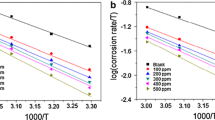Summary
Crude petroleum contains sulfur compounds, most of which are removed during refining. The corrosivity of sulfur compounds present in petroleum products is measured by means of the ASTM D-130 copper strip test, which is based on discoloration of a standard copper strip immersed into the petroleum products at 50°C for 3 h. Here the corrosivity of copper strips are tested with elemental sulfur and different mercaptans in synthetic naphtha. The great corrosive power of elemental sulfur is 3.7 times higher than that of ethylmercaptan, the most corrosive among the different mercaptans. The elemental sulfur and ethyl-mercaptan corrosion distribution on copper strips is also studied by means of the ASTM D-130 test together with electronic microscopy (SEM) and energy dispersive X-ray (EDX) techniques. These non-destructive techniques allow to know the strip corrosive morphology and to determine the sulfur concentration on the strip.
Similar content being viewed by others
References
Kalichevsky VA, Stagner BA (1942) Chemical refining of petroleum. Reinhold, New York, p 182
Lukyanitsa VG (1985) Itogi Nauki, Khim Nauki Akad, Nauk SSSR 2:13–112
Babitz M, Rocker A, Shavit-Stern AB (1968) J Mater 3:585
Cvetic B, Bosiljkov B (1982) Goriva Maziva 21:2
Tripathi RP, Gulati IB, Pandey SS, Rohatgi HS (1973) Ind Eng Chem Prod Res Develop 12:227
ASTM Standard D-130-80, Part 23 (1981) American Society for Testing and Materials, Philadelphia, p 104
Roffey R, Nilsson H, Olofsson G (1984) FDA rapport-C 40189-B4, Sweden
Holm R, Holtkamp D, Kleinstuck R, Rother HJ, Storp S (1989) Fresenius Z Anal Chem 333:546
Schreifels JA, Bagwell T, Weers JJ (1989) Corros NACE 45:84
García-Antón J, Monzó J, Guiñón JL, Gómez D, Costa J (1990) Fresenius J Anal Chem 337:382–388
Bertin EP (1975) Principles and practice of X-ray spectrometric analysis, 2nd edn. Plenum Press, New York London, p 935
Glauert AM (1977) Practical methods in electron microscopy, vol 5. Elsevier, Amsterdam, p 464
García-Antón J, Dejoz R (1988) XXII Reunión Bienal de la Real Sociedad Española de Química, Murcia, Spain. Comunicación 13, P 106. p 230
Trethewey KR, Chamberlain J (1988) Corrosion. Longman, UK, p 121
Rohlf J (1987) BIOM. A package of statistical programs applied. Biostatistics Inc, Setanket, New York
Author information
Authors and Affiliations
Rights and permissions
About this article
Cite this article
Monzó, J., García-Antón, J. & Guiñón, J.L. Influence of elemental sulfur and mercaptans on corrosion of copper strips in the ASTM D-130 test by means of electronic microscopy (SEM) and energy dispersive X-ray (EDX). Fresenius J Anal Chem 341, 606–610 (1991). https://doi.org/10.1007/BF00322271
Received:
Revised:
Issue Date:
DOI: https://doi.org/10.1007/BF00322271




